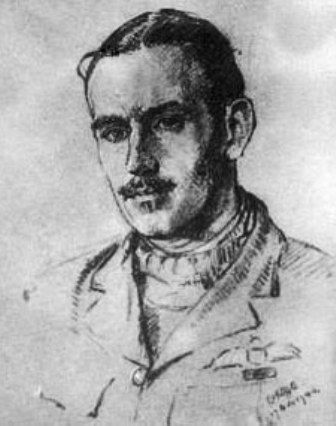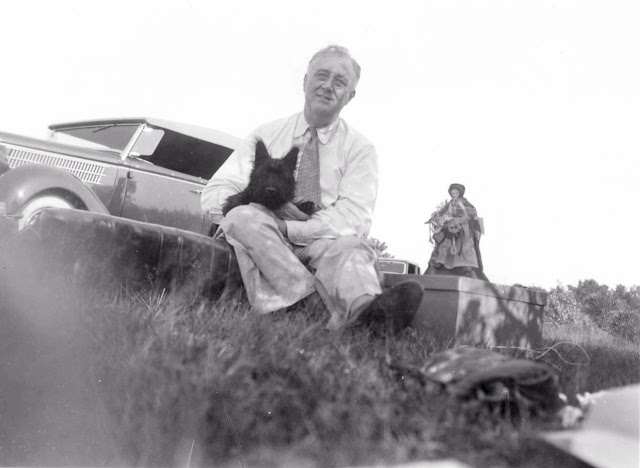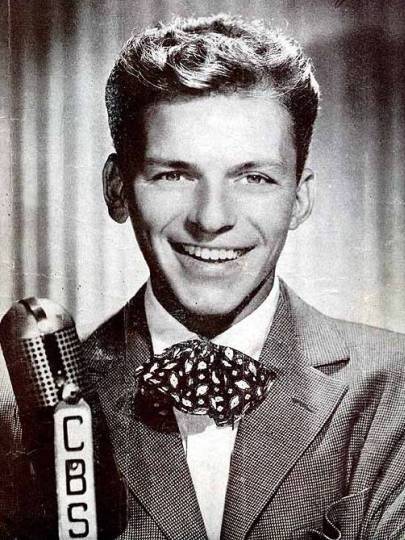Thursday 8 August 1940
Battle of Britain: Luftwaffe attacks pick up noticeably on 8 August 1940. There is reasonably good flying weather, though there are low clouds (2000 ft, 700 meters) over the Channel. Rather than 10 July 1940, today feels like the true start of what is known as the Battle of Britain. Adolf Galland later notes that the intent is to overwhelm the RAF fighter defense and, after drawing them up for combat, destroy them. Everything else is secondary.
Pursuant to Reichsmarschall Hermann Goering's directive of the 6th, the focus of attacks is supposed to be the RAF and its infrastructure. The implicit assumption is that the easy pickings in the Channel have been eliminated. However, today shows that the best-laid plans sometimes go awry, as shipping is first on the agenda.
The attacks on the 20-ship (plus 9 escorts) convoy (codename "Peewit" by the RAF and "CW9" by the Royal Navy) spotted by German Freyda radar at Wissant and sentries on Cape Gris Nez late on the 7th take place throughout the day. German radio has said that the Channel is closed to British convoys, and the Wehrmacht intends to make good on that statement. The British, on the other hand, intend to prove the Germans wrong and reassert their control over the waters just beyond their own coastline. This sets the stage for a classic battle in which both sides are trying to prove themselves "right" and make a larger point about dominance. Naturally, the sailors on the ships of both sides have nothing to say about this.
An odd circumstance occurs which is of huge portent. The Luftwaffe is slow to react because Luftlotten 2 and 3 disagree over whose zone of operations the ships lie within. As they argue about it, the ships sail on. This is a perpetual problem within the Wehrmacht, both in Luftwaffe settings and also the army (Heer), and everybody notices it but nobody ever solves it.
Generalmajor Wolfram Freiherr von Richthofen of Fliegerkorps VIII, Luftflotte 3 finally cuts the knot and sends his Stukas in after several hours' wait at about 09:00. Escorted by fighters of I,/JG27 and III,/JG26, they sink 2 ships (SS Conquerdale and SS Empire Crusader) and damage 7 others. The Stukas are hampered by barrage balloons and low cloud cover. The RAF defends with six squadrons from Nos. 10 and 11 Groups.
There are Luftwaffe fighter sweeps by JGs 3, 26, 51, 53 and 54 in the southeast as well. RAF Nos. 41, 64 and 610 Squadrons rise to meet them. The RAF loses four Spitfires and three pilots. The Luftwaffe loses one plane, but five others are either badly damaged or complete write-offs when they make it back to France.
The second attack on the Peewit convoy, which by now has made it almost to the Isle of Wight, occurs at 12:48. There are almost 60 Stukas (StG 2, StG 3 and StG 77), escorted by 30 Bf 109s (JG 27) and 20 Bf 110s (LG 1). The RAF counters with over fifty fighters from Squadron Nos. 43, 145, 238, 257 and 609 (Spitfires). The Luftwaffe loses three Stukas, with four more damaged, three Bf 109s with one damaged, and a Bf 110 with three more damaged. The Stukas sink four more ships and inflict damage on seven others.
Von Richthofen is determined to teach the British a lesson about thumbing their noses at him, so he sends a third wave of attackers against the (largely meaningless) Peewit convoy at 15:00. This is the largest effort of all, with 87 Stukas escorted by 68 Bf 109s of II,/JG 27 and some Bf 110s. The RAF Groups No. 10 and 11 meet them again with seven squadrons. The carnage is everywhere, on the sea, in the RAF, and in the Luftwaffe.
There are various ways of looking at the day's events. Altogether, it is estimated, that the RAF downs 31 Luftwaffe aircraft to 19 of its own planes. However, the Luftwaffe only lose 9 fighters, with another 8 damaged. The RAF lose 19 planes, of which 18 are fighters and the other a Blenheim bomber. In terms of fighter operations, it is not a bad day for the Luftwaffe. More significantly, the RAF loses 16 pilots permanently and several others to wounds, and pilots are a major bottleneck for fighter defense. As such, the day's balance tends to favor the Luftwaffe.
On the other hand, the Stukas are mauled throughout the day. While they are absolutely phenomenal at the precision bombing of ships, they also are proving themselves to be phenomenally easy targets for RAF fighters. This is not a cause for concern by the Luftwaffe - yet - because the fighter pilots are full of stories about their own successes which tend to exaggerate the reality of the situation. The Stuka losses, though, are becoming painful and are there to see when the planes (don't) return.
Some major decisions flow from today's events.
During the day, RAF Bomber Command raids Amsterdam-Schiphol and Valkenburg in Holland, losing a bomber. After dark, they attack the usual targets in northwestern Europe, including the port of Hamburg, electrical facilities at Cologne, and train infrastructure at Hamm and Soest. They lose a bomber in these raids as well.
The Luftwaffe continues moving its units to forward bases along the Channel. III,/JG3 moves to a converted football field at Desvres.
Battle of the Atlantic: U-37 (Kapitänleutnant Victor Oehrn) torpedoes and sinks 5380-ton British freighter Upwey Grange about 200 miles west of Ireland at 01:14. There are 36 deaths when one of the lifeboats disappears.
German raider Widder disembarks the 34-man crew of 5,850-ton Dutch collier Oostplein and sinks the ship.
British tanker Lucerna that was torpedoed and badly damaged by U-99 (Otto Kretschmer) on 2 August 1940, limps into Greenock, Scotland.
The Luftwaffe lays mines in the Thames estuary and near ports in the south of England.
Convoy OB 195 departs from Liverpool, Convoy HX 64 departs from Halifax.
Battle of the Mediterranean: The RAF and Italian Regia Aeronautica have been sparring lightly over the Libyan/Egyptian desert, and today a major battle develops. The Italians lose 7 planes and the RAF 2 Gloster Gladiator biplanes.
The second British submarine carrying spares to Malta for the new Hurricanes, HMS Proteus, arrives at Grand Harbour. HMS Pandora, which also brought in supplies, departed on the 7th. Together, this supply mission is called Operation Tube. The Proteus has a mishap when it accidentally rams a small freighter, the Andromeda, whilst shifting its berth. Andromeda sinks.
The Italians once again buzz Malta during the afternoon with half a dozen aircraft, but nothing comes of it. The War Office promises to send supplies on 7000 tons of shipping space that has opened up for it, with the government of Malta to pay for civilian goods so as to ensure secrecy.
British Somaliland: The British, having given up the key ports to the west, set up a defensive perimeter on six hills overlooking the road into Berbera. They use their recent reinforcements of the 1/2nd Punjab Regiment and the 2nd Battalion of the Scottish Black Watch to man these key positions. The Italian troops advance toward this position, which guards the British stronghold at Tug Argan pass.
The Regia Aeronautica begins attacks on British vessels in the Gulf of Aden, but has little success, and also on British positions at Berbera. The Fleet Air Arm operating from Australian cruiser HMAS Hobart, meanwhile, counters with attacks on Italian headquarters in Zeila. RAF aircraft retreat to bases in Aden.
North Africa: Italian Foreign Minister Count Galeazzo Ciano meets with Marshal Rodolfo Graziani, the new commander of Italian operations in North Africa. Ciano is upset that his father-in-law's (Mussolini's) invasion date for Egypt has come and gone. Graziani responds that the Italian forces in Libya are unprepared for operations.
German Military: Adolf Hitler is gradually interposing himself on staff decisions relating to the planning of the attack on the Soviet Union (Operation Barbarossa). He tells General Keitel to issue the Aufbau Ost directive calling for the mobilization of troops in eastern Germany and also tells General Jodl's deputy Walter Warlimont to ascertain Soviet troop positions. All of this attention underscores how serious Hitler is about the attack. He does not spend nearly as much time effort on Operation Sealion, the invasion of Great Britain.
British Military: The British War Cabinet is pleased with the progress of the air battle to date. However, Air Vice Marshall Keith Park, in charge of Fighter Command, is not so sure that this will last, stating:
Japanese Military: The Japanese launch the Yamato at Kure Naval Arsenal. It is known only as "Battleship No. 1" at this point and is capable of fielding the largest naval guns in the world.
Vichy France: Pierre Laval orders the arrest of Georges Mandel in Morocco. This is done by General Charles Nogues. He is taken to the Château de Chazeron, where all of the former French leaders are being held. This is of particular interest to British Prime Minister Winston Churchill, who does not really like Charles de Gaulle and would prefer Mandel as the leader of the Free French.
Mandel was one of the few in the French government who wished to carry on the fight against the Germans from North Africa. Mandel also happens to be Jewish. He had the opportunity to flee with de Gaulle but refused because he felt it would look bad for a Jew to run.
India: It is well known that the Nationalist leaders led by Mahatma Gandhi refuse to cooperate with war preparations without a guarantee of Indian independence. Viceroy of India Lord Linlithgow tries to cut a deal by offering nationalist leaders some constitutional reform now and re-examination of the independence question after the war. This would be done by assembling a Constituent Assembly composed of people from India's major ethnic groups to devise a new constitution. The British government goes along with this.
Burma: Nationalist leader Aung San escapes Burma and joins Japanese forces in China.
American Homefront: American factories are ramping up in response to huge new military orders. Airplane production hits 500 aircraft production per month, dwarfing that of the combatants.
"Boom Town" starring Clark Gable, Spencer Tracy, Claudette Colbert, and Hedy Lamarr premieres at Grauman's Chinese Theatre in Hollywood.
August 1940
August 1, 1940: Two RN Subs Lost
August 2, 1940: Operation Hurry
August 3, 1940: Italians Attack British Somaliland
August 4, 1940: Dueling Legends in the US
August 5, 1940: First Plan for Barbarossa
August 6, 1940: Wipe Out The RAF
August 7, 1940: Burning Oil Plants
August 8, 1940: True Start of Battle of Britain
August 9, 1940: Aufbau Ost
August 10, 1940: Romania Clamps Down On Jews
August 11, 1940: Huge Aerial Losses
August 12, 1940: Attacks on Radar
August 13, 1940: Adler Tag
August 14, 1940: Sir Henry's Mission
August 15, 1940: Luftwaffe's Black Thursday
August 16, 1940: Wolfpack Time
August 17, 1940: Blockade of Britain
August 18, 1940: The Hardest Day
August 19, 1940: Enter The Zero
August 20, 1940: So Much Owed By So Many
August 21, 1940: Anglo Saxon Incident
August 22, 1940: Hellfire Corner
August 23, 1940: Seaplanes Attack
August 24, 1940: Slippery Slope
August 25, 1940: RAF Bombs Berlin
August 26, 1940: Troops Moved for Barbarossa
August 27, 1940: Air Base in Iceland
August 28, 1940: Call Me Meyer
August 29, 1940: Schepke's Big Day
August 30, 1940: RAF's Bad Day
August 31, 1940: Texel Disaster
2020
Pursuant to Reichsmarschall Hermann Goering's directive of the 6th, the focus of attacks is supposed to be the RAF and its infrastructure. The implicit assumption is that the easy pickings in the Channel have been eliminated. However, today shows that the best-laid plans sometimes go awry, as shipping is first on the agenda.
The attacks on the 20-ship (plus 9 escorts) convoy (codename "Peewit" by the RAF and "CW9" by the Royal Navy) spotted by German Freyda radar at Wissant and sentries on Cape Gris Nez late on the 7th take place throughout the day. German radio has said that the Channel is closed to British convoys, and the Wehrmacht intends to make good on that statement. The British, on the other hand, intend to prove the Germans wrong and reassert their control over the waters just beyond their own coastline. This sets the stage for a classic battle in which both sides are trying to prove themselves "right" and make a larger point about dominance. Naturally, the sailors on the ships of both sides have nothing to say about this.
An odd circumstance occurs which is of huge portent. The Luftwaffe is slow to react because Luftlotten 2 and 3 disagree over whose zone of operations the ships lie within. As they argue about it, the ships sail on. This is a perpetual problem within the Wehrmacht, both in Luftwaffe settings and also the army (Heer), and everybody notices it but nobody ever solves it.
Generalmajor Wolfram Freiherr von Richthofen of Fliegerkorps VIII, Luftflotte 3 finally cuts the knot and sends his Stukas in after several hours' wait at about 09:00. Escorted by fighters of I,/JG27 and III,/JG26, they sink 2 ships (SS Conquerdale and SS Empire Crusader) and damage 7 others. The Stukas are hampered by barrage balloons and low cloud cover. The RAF defends with six squadrons from Nos. 10 and 11 Groups.
There are Luftwaffe fighter sweeps by JGs 3, 26, 51, 53 and 54 in the southeast as well. RAF Nos. 41, 64 and 610 Squadrons rise to meet them. The RAF loses four Spitfires and three pilots. The Luftwaffe loses one plane, but five others are either badly damaged or complete write-offs when they make it back to France.
The second attack on the Peewit convoy, which by now has made it almost to the Isle of Wight, occurs at 12:48. There are almost 60 Stukas (StG 2, StG 3 and StG 77), escorted by 30 Bf 109s (JG 27) and 20 Bf 110s (LG 1). The RAF counters with over fifty fighters from Squadron Nos. 43, 145, 238, 257 and 609 (Spitfires). The Luftwaffe loses three Stukas, with four more damaged, three Bf 109s with one damaged, and a Bf 110 with three more damaged. The Stukas sink four more ships and inflict damage on seven others.
Von Richthofen is determined to teach the British a lesson about thumbing their noses at him, so he sends a third wave of attackers against the (largely meaningless) Peewit convoy at 15:00. This is the largest effort of all, with 87 Stukas escorted by 68 Bf 109s of II,/JG 27 and some Bf 110s. The RAF Groups No. 10 and 11 meet them again with seven squadrons. The carnage is everywhere, on the sea, in the RAF, and in the Luftwaffe.
There are various ways of looking at the day's events. Altogether, it is estimated, that the RAF downs 31 Luftwaffe aircraft to 19 of its own planes. However, the Luftwaffe only lose 9 fighters, with another 8 damaged. The RAF lose 19 planes, of which 18 are fighters and the other a Blenheim bomber. In terms of fighter operations, it is not a bad day for the Luftwaffe. More significantly, the RAF loses 16 pilots permanently and several others to wounds, and pilots are a major bottleneck for fighter defense. As such, the day's balance tends to favor the Luftwaffe.
On the other hand, the Stukas are mauled throughout the day. While they are absolutely phenomenal at the precision bombing of ships, they also are proving themselves to be phenomenally easy targets for RAF fighters. This is not a cause for concern by the Luftwaffe - yet - because the fighter pilots are full of stories about their own successes which tend to exaggerate the reality of the situation. The Stuka losses, though, are becoming painful and are there to see when the planes (don't) return.
 |
| A Heinkel He 59 rescue plane. These were put to good use on 8 August 1940, and one even gets an aerial victory against a Hurricane. |
- The Admiralty suspends collier convoys. Only four of the original 20 ships reach their destination of Swanage, Dorset, with six others damaged and making any port that they can. Future coal shipments can and will be made by rail, which in fact was a superior alternative all along.
- Based on all sorts of assumptions about the progress of the battle that are highly sketchy - such as that the RAF is running low on fighters, which is not the case - the Luftwaffe high command issues the order for Operation Adlerangriff, the full-out assault on the RAF, to begin on the next convenient day of good flying weather.
During the day, RAF Bomber Command raids Amsterdam-Schiphol and Valkenburg in Holland, losing a bomber. After dark, they attack the usual targets in northwestern Europe, including the port of Hamburg, electrical facilities at Cologne, and train infrastructure at Hamm and Soest. They lose a bomber in these raids as well.
The Luftwaffe continues moving its units to forward bases along the Channel. III,/JG3 moves to a converted football field at Desvres.
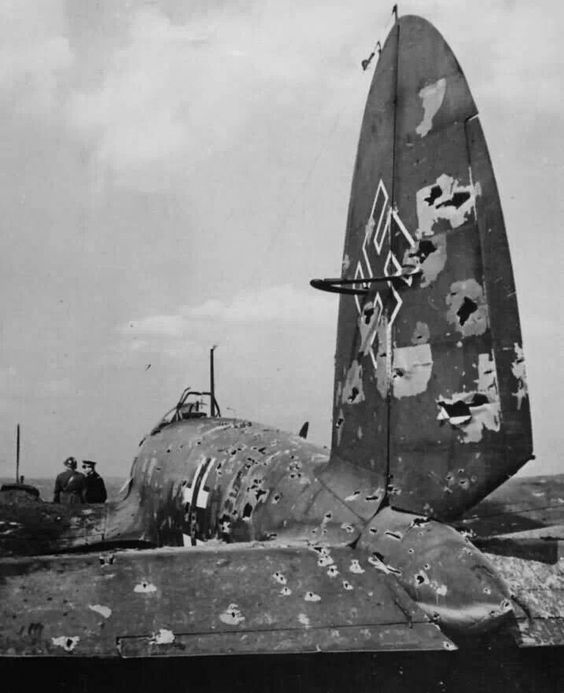 |
| A shot-up Heinkel which took massive damage but still made it in for a level landing in France, August 1940. |
German raider Widder disembarks the 34-man crew of 5,850-ton Dutch collier Oostplein and sinks the ship.
British tanker Lucerna that was torpedoed and badly damaged by U-99 (Otto Kretschmer) on 2 August 1940, limps into Greenock, Scotland.
The Luftwaffe lays mines in the Thames estuary and near ports in the south of England.
Convoy OB 195 departs from Liverpool, Convoy HX 64 departs from Halifax.
Battle of the Mediterranean: The RAF and Italian Regia Aeronautica have been sparring lightly over the Libyan/Egyptian desert, and today a major battle develops. The Italians lose 7 planes and the RAF 2 Gloster Gladiator biplanes.
The second British submarine carrying spares to Malta for the new Hurricanes, HMS Proteus, arrives at Grand Harbour. HMS Pandora, which also brought in supplies, departed on the 7th. Together, this supply mission is called Operation Tube. The Proteus has a mishap when it accidentally rams a small freighter, the Andromeda, whilst shifting its berth. Andromeda sinks.
The Italians once again buzz Malta during the afternoon with half a dozen aircraft, but nothing comes of it. The War Office promises to send supplies on 7000 tons of shipping space that has opened up for it, with the government of Malta to pay for civilian goods so as to ensure secrecy.
British Somaliland: The British, having given up the key ports to the west, set up a defensive perimeter on six hills overlooking the road into Berbera. They use their recent reinforcements of the 1/2nd Punjab Regiment and the 2nd Battalion of the Scottish Black Watch to man these key positions. The Italian troops advance toward this position, which guards the British stronghold at Tug Argan pass.
The Regia Aeronautica begins attacks on British vessels in the Gulf of Aden, but has little success, and also on British positions at Berbera. The Fleet Air Arm operating from Australian cruiser HMAS Hobart, meanwhile, counters with attacks on Italian headquarters in Zeila. RAF aircraft retreat to bases in Aden.
North Africa: Italian Foreign Minister Count Galeazzo Ciano meets with Marshal Rodolfo Graziani, the new commander of Italian operations in North Africa. Ciano is upset that his father-in-law's (Mussolini's) invasion date for Egypt has come and gone. Graziani responds that the Italian forces in Libya are unprepared for operations.
German Military: Adolf Hitler is gradually interposing himself on staff decisions relating to the planning of the attack on the Soviet Union (Operation Barbarossa). He tells General Keitel to issue the Aufbau Ost directive calling for the mobilization of troops in eastern Germany and also tells General Jodl's deputy Walter Warlimont to ascertain Soviet troop positions. All of this attention underscores how serious Hitler is about the attack. He does not spend nearly as much time effort on Operation Sealion, the invasion of Great Britain.
 |
| Air Vice-Marshal Sir Keith Park: "It's too quiet." In Germany, he is known as "the Defender of London". [© IWM (CM 3513)] |
It's too quiet; at least I've managed to re-establish my airfields, but the blighters are up to something.Military pay is never very good, even in (or perhaps especially during) times of war. The average British Army Private receives 17 shilling and 6 pence a month. Today they receive an increase of 6 pence per day.
Japanese Military: The Japanese launch the Yamato at Kure Naval Arsenal. It is known only as "Battleship No. 1" at this point and is capable of fielding the largest naval guns in the world.
Vichy France: Pierre Laval orders the arrest of Georges Mandel in Morocco. This is done by General Charles Nogues. He is taken to the Château de Chazeron, where all of the former French leaders are being held. This is of particular interest to British Prime Minister Winston Churchill, who does not really like Charles de Gaulle and would prefer Mandel as the leader of the Free French.
Mandel was one of the few in the French government who wished to carry on the fight against the Germans from North Africa. Mandel also happens to be Jewish. He had the opportunity to flee with de Gaulle but refused because he felt it would look bad for a Jew to run.
India: It is well known that the Nationalist leaders led by Mahatma Gandhi refuse to cooperate with war preparations without a guarantee of Indian independence. Viceroy of India Lord Linlithgow tries to cut a deal by offering nationalist leaders some constitutional reform now and re-examination of the independence question after the war. This would be done by assembling a Constituent Assembly composed of people from India's major ethnic groups to devise a new constitution. The British government goes along with this.
Burma: Nationalist leader Aung San escapes Burma and joins Japanese forces in China.
American Homefront: American factories are ramping up in response to huge new military orders. Airplane production hits 500 aircraft production per month, dwarfing that of the combatants.
"Boom Town" starring Clark Gable, Spencer Tracy, Claudette Colbert, and Hedy Lamarr premieres at Grauman's Chinese Theatre in Hollywood.
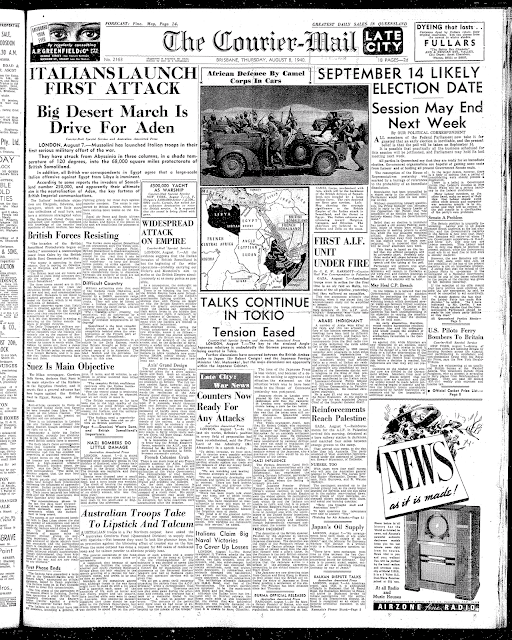 |
| Today's headlines in Brisbane. |
August 1940
August 1, 1940: Two RN Subs Lost
August 2, 1940: Operation Hurry
August 3, 1940: Italians Attack British Somaliland
August 4, 1940: Dueling Legends in the US
August 5, 1940: First Plan for Barbarossa
August 6, 1940: Wipe Out The RAF
August 7, 1940: Burning Oil Plants
August 8, 1940: True Start of Battle of Britain
August 9, 1940: Aufbau Ost
August 10, 1940: Romania Clamps Down On Jews
August 11, 1940: Huge Aerial Losses
August 12, 1940: Attacks on Radar
August 13, 1940: Adler Tag
August 14, 1940: Sir Henry's Mission
August 15, 1940: Luftwaffe's Black Thursday
August 16, 1940: Wolfpack Time
August 17, 1940: Blockade of Britain
August 18, 1940: The Hardest Day
August 19, 1940: Enter The Zero
August 20, 1940: So Much Owed By So Many
August 21, 1940: Anglo Saxon Incident
August 22, 1940: Hellfire Corner
August 23, 1940: Seaplanes Attack
August 24, 1940: Slippery Slope
August 25, 1940: RAF Bombs Berlin
August 26, 1940: Troops Moved for Barbarossa
August 27, 1940: Air Base in Iceland
August 28, 1940: Call Me Meyer
August 29, 1940: Schepke's Big Day
August 30, 1940: RAF's Bad Day
August 31, 1940: Texel Disaster
2020

